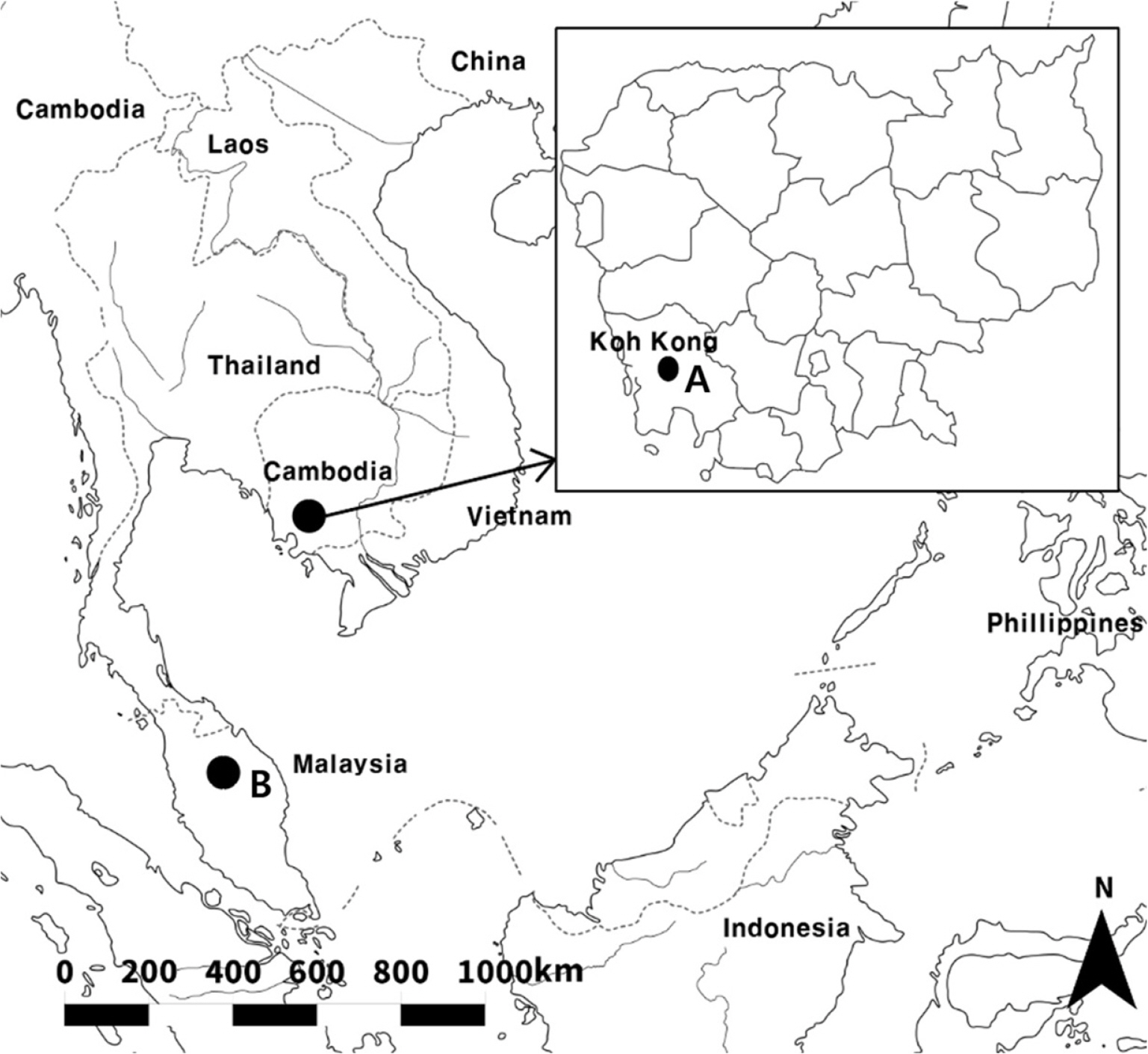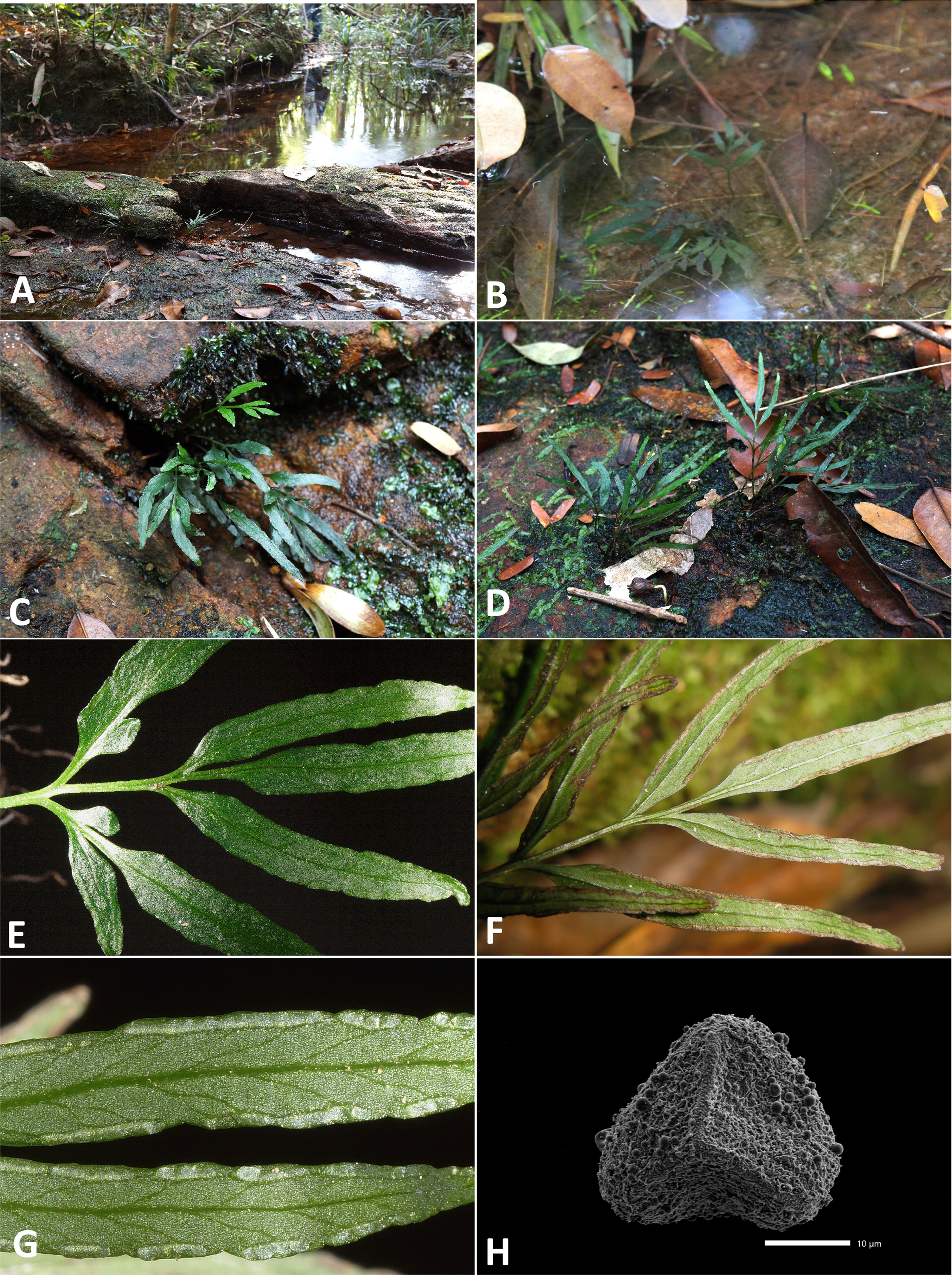INTRODUCTION
Lindsaeaceae M. R. Schomb. comprise approximately 250 species and exhibit a widespread distribution in tropical regions globally, with some species also identified in subtropical and temperate areas of South America, East Asia, and New Zealand (Kramer, 1957; Lehtonen et al., 2010). Smith et al. (2006) categorized Lindsaeaceae s.l. into eight genera: Cystodium J. Sm, Lindsaea Dryand. ex Sm., Lonchitis L., Odontosoria (C. Presl) Fee, Ormoloma Maxon, Sphenomeris Maxon, Tapeinidum (C. Presl) C. Chr., and Xyropteris K. U. Kramer. Recently, molecular evidence has shown that the genus Nesolindsaea Lehtonen & Christenh. has been added, and Lonchitis and Cytodium, previously considered exceptions, are now recognized as independent families, Lonchitidaceae and Cytodiaceae (Lehtonen et al., 2010; Christenhusz et al., 2011; PPG I, 2016).
In general terms, Lindsaea is identified by segments extending outward from the edge of the indusia, and the shape of the indusium can vary, being either linear or plate-like (Dryander, 1797). Lindsaea can be categorized into two subgenera: Odontoloma (Hook. f.) K. U. Kramer and Lindsaea (Lehtonen et al., 2010). The subgenus Odontoloma comprises species that are typically epiphytic or scandent, featuring wide-creeping rhizomes with a strongly dorsiventral stele. The subgenus Lindsaea encompasses species that are essentially terrestrial, characterized by short to moderately long-creeping rhizomes and a radially symmetric stele (Kramer, 1967).
In Flora Malesiana, the genus is further subdivided into nine sections: section Schizoloma, Temnolindsaea, Synaphlebium, Lindsaea, Osmolindsaea, Tropidolindsaea, Psammolindsaea, Isoloma, and Stenolindsaea (Kramer, 1971). Section Schizoloma is distinguished by gradually reduced upper pinnae, the absence of terminal conforming pinna, and anastomosing veins. Conversely, section Psammolindsaea is characterized by a simply pinnate blade that is apical lateral and no articulation at the bases of the pinnules (Kramer, 1971).
In a study of the fern flora of Cambodia, we found a new species of Lindsaea in Koh Kong Province. Specimens collected from Cambodia, characterized by linear blade with lateral veins joining the blade margin, are classified within the subgenus Lindsaea, and this specimen is exclusively composed of pinna, with the upper pinna displaying a distinct appearance resembling the lateral leaves. The absence of veinlet merging into the blade allows for potential inclusion in sect. Psammolindsaea. This species inhabits aquatic environments, unlike other groups, such as subgenus Lindsaea, sect. Psammolindsaea, and sect. Schizoloma, also justifies its classification as a new species. This study aims to provide a detailed description, illustration, and photographs of this new species and to compare the morphological characteristics of other species within the genus.
MATERIALS AND METHODS
In this study, we included four taxa of Lindsaea distributed in the Indochina Peninsula and Australia. Specimens were collected from Cambodia during the study from 2010 to 2013, and herbarium specimens of the L. walkera, L. ensifolia, and L. heterophylla were examined from P, JNU, KB, and HIBR (acronyms according to Thiers, 2023). Type materials have been deposited in the Honam National Institute of Biological Resources (HIBR) and National Institute of Biological Resources (KB). Comparison of the morphological characters of L. walkerae Hook., L. ensifolia Sw., and L. heterophylla Dryand. are based on herbarium specimens. The morphological characteristics of new species were observed under a microscope, and images of the spores were scanned using a field emission-scanning electron microscope.
TAXONOMIC TREATMENT
Lindsaea kohkongensis I. C. Hwang, M.-O. Moon & B.- Y. Sun, sp. nov.––TYPE: CAMBODIA. Koh Kong: Thma Bang District, near Chamnar village, 11°35′39.8″N, 103°13′17.0″E, 22 Dec 2013, B.-Y. Sun et al. C5520 (Holotype, HIBR; isotypes, HIBR, KB) (Figs. 1–4).
Plants herbs, perennial, epipetric, subaquatic, 5–16 cm tall, close to the water in valley or sometimes in water. Rhizomes terete, creeping or long creeping, 1.1–1.5 mm diam., sparsely scaly, densely end point; scales slightly spreading or appressed, castaneous, glossy, 0.9–1.6 mm long, 0.1–0.3 mm wide, 2–6 cells at base, apex aciculate. Fronds monomorphic; petiole stramineous, brownish or dark brownish at base, glossy or lusterless, 5–10 cm long, 0.4–0.9 mm in diam., trigonal or subquadrangle in cross-section, shallowly sulcate adaxially, 2 ridged distinct, sparsely scaly at base; scales ca. 0.7 mm long, less than 0.1 mm wide, 1–2 cells at base, sometimes hairlike; blades pinnate, deltoid or narrowly ovate in outline, 3–11 cm long, 2–8 cm wide, apex acute, base cuneate, herbaceous; rachis stramineous to greenish, widely sulcate, subtrigonal in crosssection, upper surface 2 ridged distinct; lateral pinnae ascending, simple, not lobed, subopposite or alternate, narrowly lanceolate or linear, 1–3 pairs, 4–11 cm long, 2–4 mm wide, apex long acuminate or acuminate, base cuneate and asymmetric (oblique), attenuate joined to rachis, petiolules distinct, wings present, 1– 4 mm long; apical pinna distinct, similar to lateral pinnae, narrowly lanceolate or linear, 3–8 cm long, 2–4 mm wide, apex long acuminate or sometimes caudate, base attenuate or cuneate, petiolules distinct, 1–5 mm long; sterile pinnae entire or slightly crenate, fertile pinnae entire. Veins veinlets free except anastomosing to sori, simple or dichotomously branched. Sori indusiate, elongate, light brown, submarginal on pinnules, continuous to 15-divided. Spores trilete, granulose.
Distribution: Cambodia (Koh Kong), Malaysia (Fig. 1)
Habitat: In valleys where evergreen broad-leaved forests and some deciduous forests grow as mixed forests, in dark and moist places, along the edges of valleys, and in crevices of rocks frequently submerged in water (Fig. 3).
Etymology: The specific epithet refers to the name of the type locality of Cambodia.
Notes: Lindsaea kohkongensis occurs in subaquatic environments, whereas its closely related species are distributed primarily in terrestrial habitats: L. walkerae thrives in moist, open places; L. ensifolia prefers dry slopes; and L. heterophylla is found in habitats ranging from dry to moist conditions (Fig. 3, Table 1). Lindsaea kohkongensis shows free venation pattern in the pinnae, where each segment of the blade is entirely independent (Figs. 2, 3), consistent with the features commonly found in Sect. Psammolindsaea (Kramer, 1971). Within this section, L. walkerae is morphologically similar to L. kohkongensis but differs from the latter by having long and creeping rhizomes, and the terminal pinna gradually reduces and becomes indistinct with a very narrow interval of the veinlets (Kramer, 1971). Lindsaea kohkongensis has the linear-lanceolate pinna and a brownish petiole.
Lindsaea heterophylla and L. ensifolia are most commonly found species in the Indochina Peninsula. These two species belong to Sect. Schizoloma characterized by fronds with gradually reduced upper pinnae and the absence of terminal conforming pinna (Kramer, 1971). Both L. heterophylla and L. ensifolia exhibit fused veins, distinguishing characteristics of the section (Kramer, 1971). However, considering the potential that our collections of L. kohkongensis might be immature individuals, additional comparisons were conducted by collecting samples in Cambodia to assess and compare the three species (Table 1). As a result, L. kohkongensis exhibits pinnate characteristics with free veinlets, distinct terminal pinnae, unlobed lateral pinnae, and creeping rhizomes (Figs. 2, 3). These characteristics indicate that L. kohkongensis is distinct from L. ensifolia and L. heterophylla (Table 1).
The terminal pinna of L. heterophylla is not distinct because the pinnae become lobed, as lobed pinnae often develop a bipinnate morphology. Although the terminal pinnae of L. ensifolia are not lobed, it has clear anastomosing veinlets, even when the pinna is very narrow (approximately 5 mm) (Table 1). In L. heterophylla and L. ensifolia, a structure resembling a false veinlet that connects between veinlets, leading to an anastomosing configuration. In L. heterophylla and L. kohkongensis, shoots are directed upward from the base and do not adhere when the pinna width is narrow. For L. kohkongensis, the veinlets are widely spaced and do not join, even when pinnae are wide (Fig. 2).
Additional specimens examined: CAMBODIA. Koh Kong: Thma Bang District near Chamnar village, 11°35′29.7″N, 103°13′27.9″E, 8 May 2010, B.-Y. Sun et al. C2742 (HIBR), 8 May 2010, B.-Y. Sun et al. C2747 (HIBR); near Stoeng kaoh Pao, elev. 289 m, 11°41′47.2″N, 103°06′57.7″E, 9 May 2010, B.-Y. Sun et al. C2777 & C2781 (HIBR).
MALAYSIA. Kedah: Peak, elev. 2,500 ft., 12 May 1915, Haift 1099 (P).















